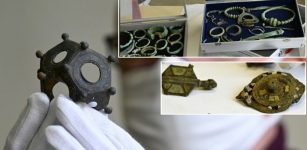Mysterious Circular Neolithic Structure Used For Unknown Purpose Found In Marliens, France
Jan Bartek - AncientPages.com - Archaeologists have unearthed a rather intriguing prehistoric construction during their excavation in Marliens, France. The function and precise age of this structure remain shrouded in mystery. However, it is postulated that its construction dates back to the Neolithic era.
General view of the excavation site at Marliens. Credit: Jérôme Berthet, Inrap
The excavations were carried out by the French National Institute of Preventive Archaeological Research (INRAP), which announced in a press release that the site has unveiled a sequence of human settlements that extend over thousands of years, from the Neolithic period, also known as the New Stone Age, to the Iron Age. The most ancient proof of habitation at this location is represented by a mysterious monument composed of three interlinked enclosures.
The uniqueness of this monument appears to be unparalleled, with no comparable structures identified thus far. While the exact dating remains ambiguous, the discovery of cut flints in the ditches hints at a possible association with the Neolithic era. To ascertain a more precise chronology, radiocarbon analyses are currently being conducted.
Evidence from the Bell Beaker period has been found just beneath the topsoil in an evenly distributed structure. This collection includes seven flint arrowheads, two archer's bracers, a flint lighter, and a copper alloy dagger.
The monument features a central circular enclosure with an approximate diameter of 36 feet. From the northern part of this circle, there is a "horseshoe"-shaped extension that measures about 26 feet in length. On the southern side, there is another extension which has an almost square shape with rounded corners.
Aerial view of the triple enclosure. Credit: Jérôme Berthet, Inrap
INRAP's research indicates that all three enclosures likely existed during the same period. Yet, numerous unanswered questions remain about the structure, including its purpose, nature, and age.
Some of the artifacts found at the site. Credit: Pauline Rostollan, Inrap
The archaeological dig revealed signs of habitation at the site dating back to the Early Bronze Age, a period in France typically estimated to span from 2300-1650 B.C. Artifacts from this era include multiple wells, with clay deposits at their base that could potentially provide insights into the region's natural environment during the initial half of the second millennium B.C., as per INRAP's findings.
The occupation during the early Bronze Age is characterized by the presence of several wells, which are the only remaining witnesses of habitats from this period.
See also: More Archaeology News
Furthermore, archaeologists have discovered a necropolis composed of five circular enclosures, which contained remnants of burials and a funeral pyre. This burial ground is believed to have originated from the period 1500-1300 B.C., corresponding to France's Middle-Late Bronze Age. The necropolis has provided several artifacts such as copper alloy pins, unique ceramic fragments, and an amber bead necklace consisting of approximately forty beads.
At the necropolis, scientists found six cremations dating from the First Iron Age. The urns, covered by a lid, contained a single bone deposit, sometimes accompanied by ornaments (bracelets and/or rings in copper alloy and iron).
Written by Jan Bartek - AncientPages.com Staff Writer























